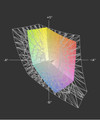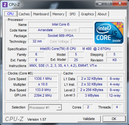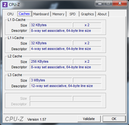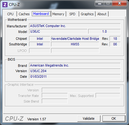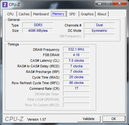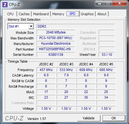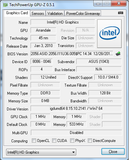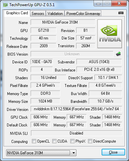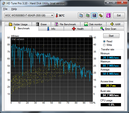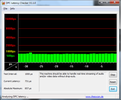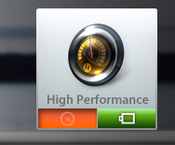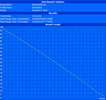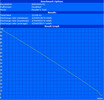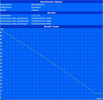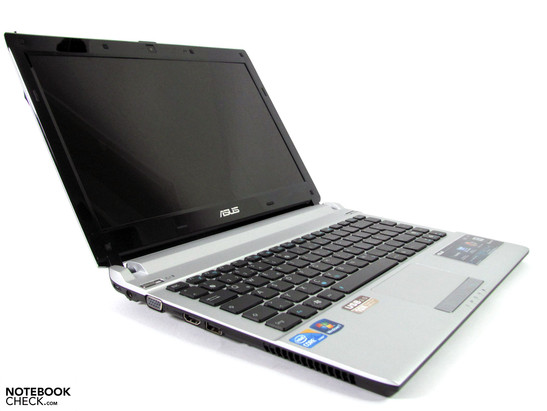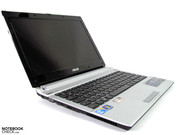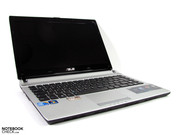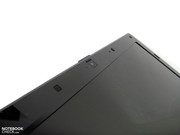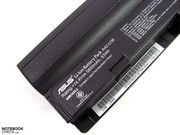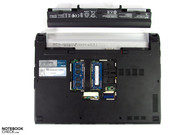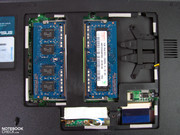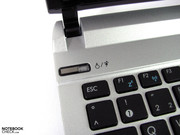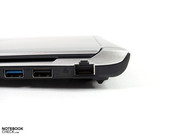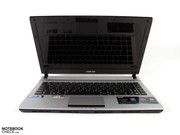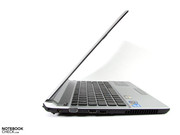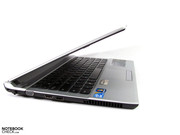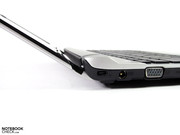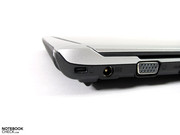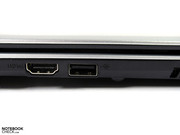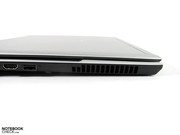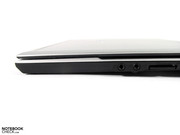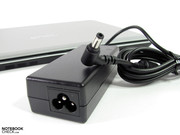Review Asus U36JC-RX081V Notebook

Small, slim, enduring and nevertheless a lot of power are characteristics that aren't easy to unite. However, today chances are better than ever since it's been recognized that pure performance takes its toll on power consumption and heat development. This is no longer contemporary and, above all, it is contra productive. New methods of reducing power consumption and simultaneously increasing computing power can be found, for example, in current CPU/GPU combinations, switchable graphics, LED displays and considerably more economic chipsets that supply interfaces intelligently with power.
The conditions are also good to create a slim, light and nevertheless high performance notebook, which can even serve with viable battery runtimes.
In order to achieve this balancing act, Asus pulls no punches. A fast Intel Core i5 CPU, Super Hybrid Engine with Intel HD Graphics and Nvidia Geforce 310M (Optimus), a 84 Wh battery, high-end lightweight materials and a selected interface configuration can quickly arouse curiosity in terms of specs. The Asus U36JC positions itself about on par with Acer Aspire 3820, Travelmate 8372, Dell Vostro V130 and Toshiba Satelite U500 at 840 euros. But it is still considerably less expensive than Samsung's QX310, Sony's Vaio S13 or even Apple's MacBook .
Case
The era of high-gloss surfaces is apparently coming to an end. More and more new releases are fortunately leaving out these very sensitive materials and are returning to more viable surface quality. Excepting the display bezel, Asus has also linked up to this trend and uses an aluminum magnesium alloy for the critical areas. That isn't only beneficial for the material's haptics, but also has a positive effect on the case's torsional stiffness. The wrist-rest is firm and can only be depressed marginally with strong pressure. Even the base unit as a whole can only be marginally twisted, if at all, with a lot of determination. No creaking, crackling or rattling is noticed.
The bottom also makes a very robust and resistant impression. The RAM can easily be replaced via the centrally located opening. If you have to access the mass memory, you will have to penetrate even further into the case and thus remove the bottom tray. The battery fits tight in its intended compartment and can be secured additionally. Our model, with an 8 cell battery, weighs 1.69 kg and is jacked up a bit at its rear. An alternative with a 4 cell battery allegedly only weighs 1.44 kg and delivers the promised case height of 19 mm. Contrarily, the test device reaches a height of 30 mm at the rear and even without the battery the advertised 19 mm are surpassed with the rubber feet. So, this is only actually reached at the front. Otherwise, the case width of 322 mm and depth of 232 mm aren't record-breaking, but in comparison to other 13" components quite impressive.
The base plate and display are joined by a currently modern hinge design, flange-mounted on the rear, which does its job well. The display only starts to teeter during strong surface movements. A drawback of this build is that the rear has to be exempted from interfaces. The display is kept well in position in a closed state. However, the sides that don't close flush could be a problem since foreign objects could penetrate through the gap, between display and keyboard. Although the display lid has turned out very thin with a thickness of 2-4 mm, it is remarkably robust. It can be bent by pulling and twisting at its corners, but isn't at all inferior in comparison with the majority. Nevertheless, image distortions perceived as wave development can be provoked with medium pressure on display lid and display bezel.
Connectivity
The Asus U36JC is not a connectivity miracle, but you'll find everything that is really required. A digital video out, HDMI in this case, provides for a perfect picture quality on external monitors and TVs. External (USB 3.0) hard disks can be connected via USB 3.0 and data is thus transferred a lot faster than via the two installed USB 2.0 ports. USB 3.0 delivered 96.4 MB/s and the USB 2.0 27.1 MB/s in the test. The cardreader, which supports most formats, achieved the standard 17.1 MB/s with a SDHC memory card. Apart from that, you'll find audio in/out, gigabit LAN and an additional analog VGA out (provides a good picture in 1280x1024). There is no optical drive.
Obviously, the attempt of placing the ports in the back part of the sides has been successful. Thus, an almost conflict-free work zone has been created. Merely the audio port on the right might get in the way of using a mouse when cables are connected, in particular for right handed users. The power cable is angled and can therefore nicely disappear towards the rear.
Communication
WLAN 802.11 b/g/n, as an Atheros 9258 chip, is installed for wireless connectivity. Strangely enough, it merely supports b/g according to our tools. However, the data rates were on the usual n standard in a short speed test. Thus, they coincide with the manufacturer's specs. Bluetooth 2.1 +EDR is also installed. UMTS is generally not yet available. The webcam isn't quite up to date with a scanty resolution of 0.3 MP.
Supplies / Warranty
There are almost as good as no supplies offered for the Asus U36JC. The 4 cell battery is currently not available in Germany / Austria. The scope of delivery is also sparse. There is merely a driver CD, a Velcro for the power adapter and a microfiber cloth for the display and bezel in the package. A 24 month warranty is granted.
Input Devices
Keyboard
The keyboard in chiclet design is pleasing. Large keys, familiar layout and contrast rich, clear lettering are things that are noticed at first glance. Special functions can be enabled via FN combinations and multimedia control is incorporated in the arrow keys. Even the inner values are right. The stroke is pleasantly soft and the medium key drop bids many users a familiar key response. The input field fits tight and can't be bent thanks to the aluminum magnesium frame. The pressure point is well palpable and a coiling of single keys can't be determined. The stroke noise is very restrained. Therefore, it should satisfy prolific typists.
Touchpad
The large touchpad bids a lot of room for multi-finger gestures and has been given a very good responsiveness. Rotating, zooming, three finger tapping, etc. work perfectly. As usual, fine tuning can be set in Synaptics options. The gliding traits are agreeable and finger taps are accepted reliably. The correlating touchpad key is smooth and is equally generous. The key's high-gloss surface looks a bit greasy after some use, though.
Display
A 13.3", 16:9 LED display is installed in the Asus U36JC with a resolution of 1366x768 (WXGA) pixels. The dot density is 118 dpi and thus represents a more balanced ratio of desktop surface and content size for most users.
| |||||||||||||||||||||||||
Brightness Distribution: 88 %
Center on Battery: 187 cd/m²
Contrast: 142:1 (Black: 1.44 cd/m²)
41.41% AdobeRGB 1998 (Argyll 3D)
59.8% sRGB (Argyll 3D)
40.03% Display P3 (Argyll 3D)
A major weakness of the display is the reflective surface. Depending on the lighting conditions, intense reflections come to the fore and the actual content is superimposed. The darker the content and the brighter the ambient lighting, the stronger this effect appears. This condition can only be minimized at the cost of ergonomics by increasing the display's brightness up to 205 cd/m2 indoors. However, this is rewarded with headaches in the long run since 130 cd/m2 would suffice in most cases.
You can't do much about this drawback outdoors, either. The maximum brightness of 205 cd/m2 is just not enough. Moreover, the maximum possible brightness in battery mode was limited to 187 cd/m2 in the test device. There is also no possibility to change this in the bios either.
The average brightness reaches 192 cd/m2 at all nine measuring points when connected to the mains. The illumination is also quite homogeneously distributed with 88%.
The other display qualities correspond to the otherwise common low standard. The color spectrum is remote from the sRGB color space. The contrast ratio of 142:1 is minimalistic and the viewing angle stability struggles with evident weaknesses on the vertical plane. On the whole, the colors look pallid, black is rather more gray and, if you move to far from the perfect viewing position, you will also have to cope with inverting or bleaching contents.
Performance
Asus especially heralds the processor's performance in the product description. It allegedly provides a considerably higher performance than the alternatives with lower power consumption. Intel's Core i5-480M is used in the test model, which is among the top 30 of all notebook CPUs. 2 processor cores that can process 4 threads at the same time due to Hyper Threading, Turbo Boost that allows a clock rate from 2.6 up to 2.93 GHz in single core application, a 3 MB L3 cache and an incorporated Intel HD graphics unit are computing performer's most important basic specs. This is enough to leave all ULV, LV and even the entire range of mobile AMD processor behind.
Intel's HM55 chipset serves as the system platform. Asus has, as mentioned in Connectivity, supplemented it with USB 3.0. A 4 GB DDR3 RAM and a 500 GB hard disk finish off the main components.
The Asus U36JC has a special feature in the graphics field. Intel's HD graphics incorporated in the processor is complemented with an additional Nvidia's Geforce 310M. Both chips can be used by Nvidia's Optimus technology and should provide more performance, respectively lower power consumption, depending on the requirements.
The benchmark results confirm that the 13 incher has a very good CPU performance, as expected. SuperPi 32M is calculated win 856s, wPrime 1024m in 539s and we receive 3884 points in Cinebench R10 64 bit (single) and 8969 points (multi). The Core i5-480M CPU achieves 42990 points in the SiSoft Sandra Dhrystone benchmark, and 30500 points in the Whetstone. Thus, the best possible performance is always made available for every single task with Hyper Threading and Turbo Boost.
The graphics field should be looked at more discriminately since two different graphic chips are in charge here. A look in the Intel HD graphics option settings once again reveals the senseless pre-settings. According to these, you should work as energy efficient as possible in mains operation and High Performance is made available for battery mode. However, this is only important for those who expect the highest possible performance when using the Intel graphics, in terms of performance. Therefore, it is recommendable to take a look at the settings.
The difference between both Intel alternatives is almost 800 points (1489 to 2243) in Cinebench R10 64 bit OpenGL Shading. The Geforce 310M however adds a good portion to that and reaches an almost twice as high score with 4267 points. This ratio looks similar in 3DMark Vantage. Intel achieves 316 points and Nvidia 1019 points. The Nvidia solution is noticeably better in comparison to Intel's HD graphics. Nevertheless, it's not strong enough for current, 3D-heavy games in medium or high quality settings.
At least the CUDA engine has a significant advantage in video converting. With the right program, such as Badaboom from Elemental, converting can be passed on to the graphics chip and thus still has enough system reserves for "normal" work left over. When the same task is managed by the CPU, the computer is usually busy with this task for a longer period and occupied. The Geforce 310M achieves 47.6 fps while converting our DVD test video into an iPhone compatible format (H.264, 427x320).
| low | med. | high | ultra | |
|---|---|---|---|---|
| StarCraft 2 (2010) | 55 | 26 |
We test to what extent latencies could turn up at the interfaces while interacting with external devices with the DPC Latency Checker. We receive a throughout "green" picture with harmless 857µs in the absolute maximum. Consequently, sound crackling, synchronization errors or the like shouldn't occur.
| PCMark Vantage Result | 5505 points | |
Help | ||
The application performance makes an overall very good impression. All tasks are finished well in PCMark Vantage. However, especially the hard disk develops an impairing effect and thus prevents reaching a better total score. Nevertheless, the result of 5505 points is very impressive and no restrictions should be expected during routine office and internet use. There are enough performance reserves available to still manage many tasks in energy saving settings very smoothly.
| 3DMark 06 Standard Score | 3025 points | |
| 3DMark Vantage P Result | 1019 points | |
Help | ||
The mass memory, WD5000BEVT, installed in the test model comes from Western Digital and has a capacity of 500 GB. This is a lot of room for data, media and programs. The 2.5" drives works with 5400 rpm and is, in view of performance, in the lower midfield of current notebook hard disks. With an average transfer rate of 59 MB/s and access times of over 20 ms, it won't be able to tackle everything. For more information see our comprehensive HDD benchmark table. This could be improved with a faster conventional hard disk or a solid state drive. Since Asus currently doesn't offer any alternatives, you would have to take care of this upgrade yourself.
Emissions
System Noise
The noise emissions can generally be described as low and of an unobtrusive quality. Although the fan is frequently inactive during low and small load, you almost always have a basic noise level of 32.2 dB(A), which we ascribe to the hard disk. When it turns itself off after a longer period of idle, the U36JC is even noiseless. An occasional hard disk clacking of 33.4 dB(A) turns up every now and again (likely the adjusting / parking of write/read heads). The noise level increases to a still moderate 38.3 dB(A) during medium load. You will have to live with a slightly fluctuation 49.2 dB(A) during full capacity. However, to accomplish the latter, it's necessary to provide the system with a large amount of tasks.
Noise level
| Idle |
| 32.2 / 32.2 / 32.2 dB(A) |
| HDD |
| 33.4 dB(A) |
| Load |
| 38.3 / 49.2 dB(A) |
 | ||
30 dB silent 40 dB(A) audible 50 dB(A) loud |
||
min: | ||
Temperature
The heat development behaves accordingly to performance requirement. While a maximum of 30.1°C are reached during normal work without graphics or CPU heavy tasks, the temperature increases to 42.6°C under load. But this rate is also absolutely unpretentious and no restrictions should be expected.
(±) The maximum temperature on the upper side is 42.4 °C / 108 F, compared to the average of 35.9 °C / 97 F, ranging from 21.4 to 59 °C for the class Subnotebook.
(±) The bottom heats up to a maximum of 42.6 °C / 109 F, compared to the average of 39.3 °C / 103 F
(+) In idle usage, the average temperature for the upper side is 22.3 °C / 72 F, compared to the device average of 30.8 °C / 87 F.
(+) The palmrests and touchpad are cooler than skin temperature with a maximum of 29.1 °C / 84.4 F and are therefore cool to the touch.
(±) The average temperature of the palmrest area of similar devices was 28.2 °C / 82.8 F (-0.9 °C / -1.6 F).
Speakers
The loudspeakers located in the front area radiate their sound toward the user. However, the low maximum volume is hardly suitable for presentations or demonstrations. As usual, you find an unbalanced sound in terms of sound characteristics. It is very treble-heavy and especially leaves out basses and midranges. Nevertheless, it suffices for background music or internet movies.
Battery Life
Asus has given the U36JC a very high capacity 8 cell battery. 84 Wh are very unusual for a 13" notebook. A 4 cell battery is allegedly also available, which particularly would have an advantage on weight and height. The smaller battery is currently neither found alone nor are there configurations with this alternative.
The lavish battery capacity is supported by low power consumption. We measured rates of 9.1 watts to 13.7 watts during little load. The system treats itself to 46 watts in medium load and, occasionally, even to almost 80 watts (CPU only: 66 watts).
Asus has extended the energy saving profiles, known from Windows 7, by its own (Entertainment, Quiet Office, High Performance and Battery Saving). They can be easily switched via the Power4Gear button. Moreover, Nvidia's Optimus has its fingers in the pie and switches automatically between Intel and Nvidia graphics, depending on the application. You can intervene in both technologies and adjust the settings to suit your personal needs.
| Off / Standby | |
| Idle | |
| Load |
|
Key:
min: | |
In any event, you should take a look at the Intel graphics setting options. We yet again found contra productive settings here. Battery mode was set to "High Performance" (graphics run on maximum clock rate), which leads to a minimum battery life of over 60 min (543 min) in BatteryEater's Reader's Test.
With the right setting ("maximum battery life" – graphics clocks down to a minimum), a considerably better runtime of 609 min can be reached with the Intel HD graphics. Thus, Asus also keeps its promised theoretical battery life 10 hours.
Then again, it looks slightly different in practical use. A touch of more brightness, enabled WLAN and surfing on the internet cause a few more watts in power consumption and the runtime is reduced to 487 min. When you watch movies via the hard disk, the battery capacity only lasts for 336 min.
However, you have to look at the settings here as well. Nvidia's graphics is first automatically selected for the Windows Media Player and reduces the battery life by about an hour. Logically, you definitely have to count with a shorter battery life when an external optical drive is used for watching movies.
Verdict
Asus has done a lot of thing right and has set up a really attractive subnotebook. Highlights are the slim and light case with high-quality material haptics, the very good battery life and the nevertheless system's high performance. The Nvidia's CUDA engine rather falls into a niche, as it's really only supported by few programs until now. However, video converters will be happy about it.
On the other hand, we find the inappropriate display highly restricting again. The screen isn't much fun and basically obliterates all other mobility advantages with its reflective surface, low contrast ratio and, for outdoor use, too low brightness. The fact that the installed hard disk rather belongs to the slower category and also that 1-2 USB ports would have been desirable, is a drawback but not as extremely restricting.
The Asus can still count the good keyboard, USB 3.0, HDMI and the low temperature development on its pro side. The warranty period is 24 months and the price is very fair when compared to the competition.















